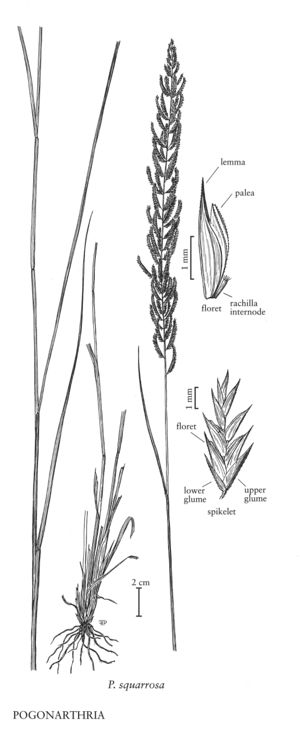Pogonarthria squarrosa
Plants perennial; densely cespitose. Culms 27-100 (140) cm, stiffly erect, unbranched, glabrous. Sheaths mostly shorter than the internodes, glabrous; ligules 0.5-1 mm, of hairs; blades 4-30 cm long, 2-5.5 mm wide, adaxial surfaces smooth to slightly scabrous. Panicles 20-30 cm, with 50+ branches; rachises more or less scabrous; branches 2-3 cm, arcuate, axes more or less scabrous. Spikelets usually with 4-8 florets. Lower glumes 0.8-1.5 mm, 1-veined; upper glumes about 2.5 mm, 1-3-veined; lemmas about 3 mm, glabrous, mostly smooth, keels scabridulous; paleas about 2 mm, keels scabrous; anthers about 1 mm. Caryopses 1.2-1.3 mm, fusiform, light-brown; embryos less than 1/2 as long as the caryopses. 2n = 120.
Discussion
Pogonarthria squarrosa is native to eastern and southern Africa, where it is said to be common. In the Flora region, P. squarrosa grows spontaneously only in a small area in the foothills of the Huachuca Mountains, Cochise County, Arizona, at an elevation of about 1450 m, where it seems to be competing well with native grasses and Eragrostis lehmanniana, another African introduction. The plants tend to grow in rather dense colonies of a few square meters, scattered through the area. It is a handsome species that turns reddish-brown as it matures, causing it to stand out among its associates.
Selected References
None.
Lower Taxa
"decumbent" is not a number.
